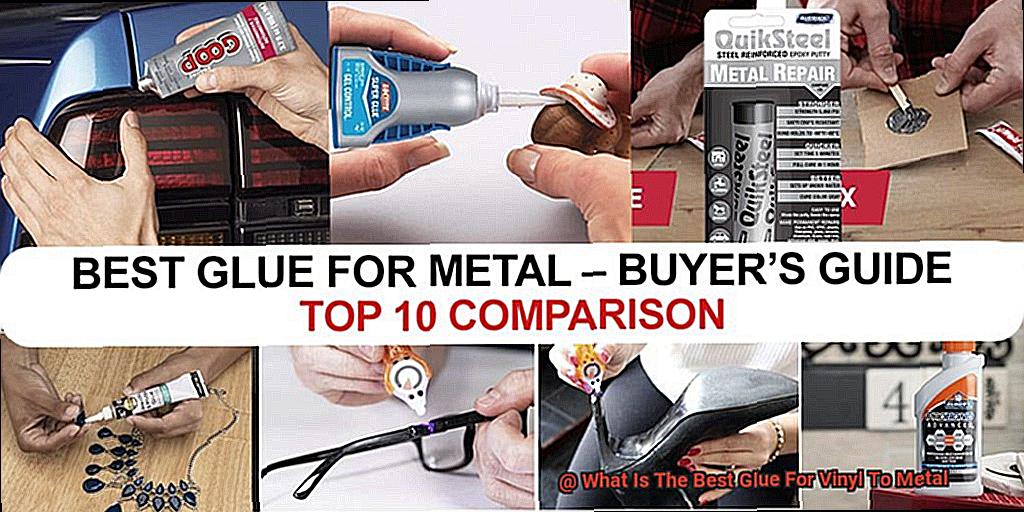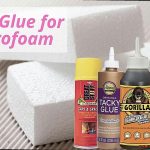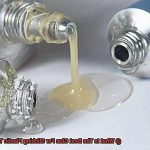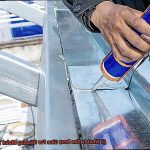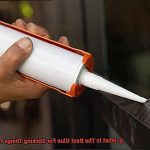Are you a craft enthusiast or a DIY guru? If so, you know that bonding vinyl to metal can unlock a treasure trove of creative possibilities. But here’s the catch – finding the right adhesive can feel like searching for a needle in a haystack.
We’ve delved deep into the realm of do-it-yourself projects to bring you an expert guide on selecting the absolute best glue for attaching vinyl to metal. Prepare yourself for a captivating journey through the world of chemical marvels as we unveil the secrets behind achieving an unbreakable and enduring bond.
So, grab your trusty toolkit and get ready to embark on an exhilarating exploration of the enchanting glue universe.
What is Vinyl and Metal?
Contents
- 1 What is Vinyl and Metal?
- 2 What Types of Adhesives are Suitable for Bonding Vinyl to Metal?
- 3 The Benefits of Using Epoxy Adhesive
- 4 The Benefits of Using Cyanoacrylate Adhesive
- 5 Preparing the Surfaces for Bonding
- 6 Applying the Adhesive
- 7 Curing Time and Additional Precautions
- 8 Enhancing the Performance with a Primer or Bonding Agent
- 9 Conclusion
Vinyl and metal are versatile materials used in various industries and applications. When it comes to bonding them together, selecting the right adhesive is crucial. In this article, we will explore the characteristics of vinyl and metal and discuss the best glue options for their bonding.
Understanding Vinyl:
Vinyl, or polyvinyl chloride (PVC), is a synthetic plastic polymer known for its durability, low cost, and resistance to moisture and chemicals. It can be found in rigid or flexible forms, making it suitable for flooring, window frames, pipes, electrical cables, and clothing.
Exploring Metals:
Metals like aluminum, steel, iron, copper, and brass are known for their strength and versatility. Used in construction, manufacturing, transportation, and more, metals can be shaped into sheets, rods, wires, and plates to suit specific purposes.
Choosing the Right Adhesive:
For vinyl-to-metal bonding, epoxy adhesives are recommended due to their excellent bonding strength and resistance to chemicals, heat, and moisture. They work well with various metals.
Cyanoacrylate adhesive (super glue) is another popular option known for its fast curing time and ability to bond different materials quickly. However, not all glues work well for vinyl-to-metal bonding.
Surface Preparation and Application:
Before applying any adhesive, proper surface preparation is vital. Both vinyl and metal surfaces should be clean, dry, and free from dust, grease, or contaminants. For epoxy adhesive, mix the resin and hardener as per instructions. Apply the mixed adhesive evenly onto both surfaces using a brush or spatula. Press the surfaces firmly until the adhesive cures.
For cyanoacrylate adhesive, apply a small amount to one surface and press the two surfaces together firmly. The adhesive bonds quickly.
What Types of Adhesives are Suitable for Bonding Vinyl to Metal?
When it comes to the unlikely pairing of vinyl and metal, finding the right adhesive is essential for a strong and long-lasting bond. Whether you’re a DIY enthusiast or just need to repair something around the house, this guide will provide you with valuable insights on the top adhesives that are best suited for bonding vinyl to metal.
Epoxy – A Superhero Glue:
For unbeatable strength and durability, look no further than epoxy adhesive. This adhesive acts as a superhero, capable of handling extreme conditions like high temperatures and wet environments. If your vinyl-metal creation is destined for the outdoors or a high-stress area, epoxy is your go-to adhesive.
Super Glue – The Instant Fixer:
When time is of the essence, super glue, also known as cyanoacrylate adhesive, comes to the rescue. This adhesive works at lightning speed, forming a strong bond between vinyl and metal surfaces in an instant. However, be cautious with prolonged exposure to sunlight and chemicals as it may weaken over time.
Polyurethane – Your Flexible Friend:
If flexibility is key, polyurethane adhesive will be your new best friend. Its exceptional flexibility allows it to withstand vibrations and movement without sacrificing its grip. Additionally, its weatherproof nature makes it suitable for both indoor and outdoor applications, making it an ideal choice for cushions or upholstery.
Pressure-Sensitive Adhesives (PSAs) – Simplicity at its Finest:
Sometimes, simplicity is what we need. Enter pressure-sensitive adhesives (PSAs). Available in tape or sheet form, these adhesives are activated simply by applying pressure. No drying or curing time required. PSAs offer a quick and hassle-free solution for bonding vinyl to metal.
Preparation is Key:
Before applying any adhesive, ensure that both the vinyl and metal surfaces are clean and dry. Remove any dust, grease, or residue that could hinder the bonding process. For an extra layer of security, consider using a primer or bonding agent specifically designed for vinyl-to-metal bonding.
The Benefits of Using Epoxy Adhesive
In the world of adhesives, epoxy adhesive stands as a mighty superhero when it comes to bonding vinyl to metal surfaces. With its exceptional strength, resistance to environmental factors, and ability to fill gaps, epoxy adhesive has rightfully earned its reputation as the go-to choice for creating durable and long-lasting bonds. Let’s dive deeper into the benefits of using epoxy adhesive for vinyl to metal bonding.
First and foremost, epoxy adhesive is renowned for its exceptional strength. It provides a bond that is as strong as steel, ensuring that your vinyl and metal materials will stay firmly attached. Whether you’re working on a DIY project or repairing a broken item, epoxy adhesive guarantees that your bond will withstand the test of time.
In addition to its impressive strength, epoxy adhesives are resistant to various environmental factors. They can endure moisture, heat, and chemicals, making them perfect for outdoor applications or environments where the bonded materials may be exposed to harsh conditions. So whether you’re bonding vinyl to metal for an outdoor sign or a piece of furniture that will face the scorching sun, epoxy adhesive will keep your bond intact.
Another advantage of epoxy adhesive is its remarkable ability to fill gaps and provide excellent gap-filling properties. This becomes particularly useful when bonding vinyl to metal surfaces that may have uneven or irregular surfaces. Epoxy adhesives can seamlessly fill in those gaps and create a tight bond between the two materials, ensuring that there are no weak spots in your bond.
Epoxy adhesives also offer outstanding temperature resistance. Some formulations can withstand extreme temperatures ranging from -40°C to 150°C. This makes them suitable for applications that involve exposure to high or low temperatures. So whether you’re bonding vinyl to metal for a car interior or an industrial application that requires heat resistance, epoxy adhesive has got you covered.
Furthermore, epoxy adhesives have a long shelf life and can be stored for extended periods without losing their effectiveness. This is particularly beneficial for users who may need to store the adhesive for future use. With epoxy adhesive, you won’t have to worry about your adhesive going bad before you have a chance to use it.
In addition to its excellent bonding properties, epoxy adhesive also provides good electrical insulation. This makes it suitable for applications where electrical conductivity needs to be avoided or controlled. So whether you’re bonding vinyl to metal for an electrical device or undertaking a wiring project, epoxy adhesive will ensure that your bond is secure and your electrical connections are protected.
Not only are epoxy adhesives strong and resistant, but they are also easy to apply and require minimal surface preparation. They can be used on a variety of materials, including different types of vinyl and metals, making them versatile and suitable for a wide range of applications. With epoxy adhesive, you can bond vinyl to metal quickly and efficiently.
The Benefits of Using Cyanoacrylate Adhesive
Cyanoacrylate adhesive, also known as super glue, is the superhero when it comes to bonding vinyl to metal. Its benefits are as clear as day, making it a popular choice for professionals and DIY enthusiasts alike.
First and foremost, cyanoacrylate adhesive is like the Flash of adhesives. It bonds faster than you can say “super glue,” forming a strong connection in just seconds. This quick bonding time is perfect for those vinyl-to-metal projects that need to be done in a jiffy.
But speed isn’t its only superpower. Cyanoacrylate adhesive also boasts excellent adhesion properties, especially on nonporous surfaces like metal. Once it’s set, this adhesive forms a tough bond that can withstand all sorts of stresses and strains. No need to worry about your vinyl peeling off when things get a little shaky.
Speaking of durability, cyanoacrylate adhesive laughs in the face of moisture and temperature extremes. Once cured, it remains stable and unaffected by the elements. Rain or shine, hot or cold, this adhesive will keep your vinyl and metal buddies together through it all.
Chemical resistance is another feather in cyanoacrylate adhesive’s cap. It can handle exposure to solvents, oils, and other chemicals without breaking a sweat. So if your vinyl-to-metal project involves a chemical-heavy environment, this adhesive has got your back.
And here’s the best part: cyanoacrylate adhesive is a breeze to use. No extensive cleaning or priming required. It sticks to smooth and rough surfaces alike, making your life easier and your project faster. Plus, it comes in different viscosities, so you can choose the right one for your specific needs. Thin for precision work or thick for filling gaps – the choice is yours.
Preparing the Surfaces for Bonding
Get ready to embark on an exciting bonding adventure as we explore the world of gluing vinyl to metal surfaces. Whether you’re a crafting enthusiast or a DIY pro, understanding how to prepare the surfaces is essential for a successful and long-lasting bond. So, let’s dive in and discover the key steps to achieve the perfect bond.
Step 1: Cleanliness is Key
To kick-start the bonding process, it’s crucial to thoroughly clean both the vinyl and metal surfaces. Bid farewell to dirt, grease, or debris by using a mild detergent or cleaning solution. Removing these contaminants ensures that the adhesive can work its magic without any hindrance.
Step 2: Roughen Up for Enhanced Grip
Smooth metal surfaces may not provide the best grip for vinyl glue. To overcome this challenge, grab some fine-grit sandpaper and gently roughen up the metal surface. These tiny scratches create more surface area for the glue to hold on to, resulting in a stronger and more reliable bond.
Step 3: Prime for Perfection (optional)
Some vinyl glues require a primer to optimize adhesion on metal surfaces. Check the instructions provided by the adhesive manufacturer to determine if priming is necessary. If it is, apply a thin coat of primer using a brush or sponge, ensuring it dries according to the recommended time on the label.
Step 4: Test Fit and Align with Precision
Now that your surfaces are meticulously prepped, it’s time for a test fit. Place the vinyl piece onto the metal surface and make any necessary adjustments before proceeding with gluing. Once perfectly aligned, mark the position as a reference point during the bonding process.
Step 5: The Glue that Binds
Selecting a high-quality adhesive specifically designed for bonding vinyl to metal is paramount. Follow the manufacturer’s instructions regarding application methods and coverage rates. Apply an even layer of glue onto one surface using a brush or applicator tool, ensuring thorough coverage.
Step 6: Joining the Surfaces with Confidence
The anticipation builds as you carefully align the vinyl piece with the marked position on the metal surface. Apply even pressure across the entire bond area to ensure excellent contact between the surfaces. For added support, utilize clamps or weights to hold the pieces together while the glue cures.
Step 7: Patience Ensures Perfection
Exercise patience and allow sufficient curing time for the adhesive to work its wonders. The length of time will vary depending on the adhesive type and environmental conditions. Always refer to the manufacturer’s instructions for specific recommendations. Avoid subjecting the bonded surfaces to stress or load until the glue has fully cured.
Applying the Adhesive
Today, we’re delving into the fascinating world of adhesives and uncovering the secrets to successfully bonding vinyl to metal surfaces. Whether you’re repairing car interiors or creating stunning metal and vinyl décor pieces, this skill will take your projects to new heights. So, let’s dive in.
Cleanliness is crucial when it comes to applying adhesive. Before applying any glue, make sure both the vinyl and metal surfaces are squeaky clean. Banish dirt, grease, and debris with a mild detergent or rubbing alcohol, ensuring a pristine canvas for bonding.
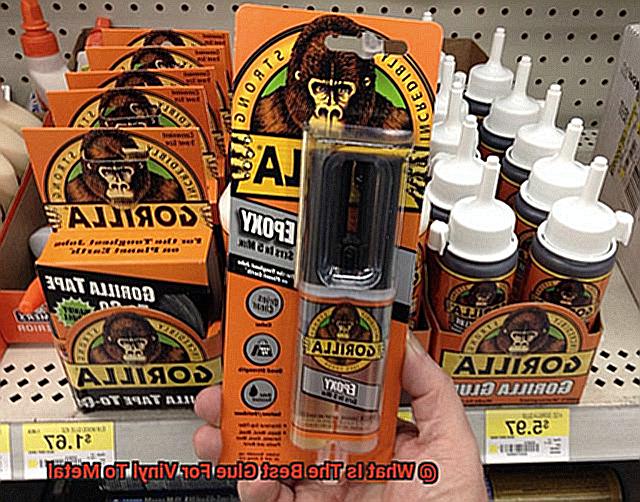
Next, let’s roughen up that metal surface a bit. Grab sandpaper or a wire brush and gently roughen the metal. This step might seem counterintuitive, but it actually creates a better bonding surface for the glue, resulting in a stronger hold.
But before you start gluing everything together, take a moment to test the adhesive on a small, inconspicuous area. This simple step will save you from potential disasters down the road. Ensure compatibility with your specific vinyl and metal combination before committing.
Now it’s time to unleash the adhesive. Follow the manufacturer’s instructions meticulously, paying close attention to recommended temperature and humidity conditions for optimal bonding. Apply the glue evenly and thinly using a brush, roller, or applicator recommended by the manufacturer. Remember, less is more – excessive glue can lead to weak bonds or unsightly oozing.
With the adhesive applied, it’s time to bring those vinyl and metal surfaces together. Utilize clamps or apply even pressure across the bonded area for a tight connection. Maintain this pressure for the recommended curing time specified by the adhesive manufacturer.
Once the adhesive has fully cured, it’s time for some cleanup. Bid farewell to any excess glue using a suitable solvent as instructed by the manufacturer. Be cautious with harsh chemicals that could harm your precious vinyl or metal surfaces.
Voila – a successful bond between vinyl and metal surfaces. Just remember, different adhesives have varying curing times, so plan accordingly. Additionally, consider the specific application requirements when selecting an adhesive for vinyl to metal bonding. Temperature resistance, flexibility, and durability are all critical factors to ensure your adhesive meets your project’s demands.
Curing Time and Additional Precautions
Curing time, the period in which glue dries and forms a robust bond between vinyl and metal, is a crucial step in the adhesive process. Imagine carefully applying the glue, aligning the surfaces perfectly, and then waiting for the magic to happen. Curing time refers to the duration it takes for the glue to fully dry and create that unbreakable bond. It’s like waiting for a delicious cake to bake – patience is key.
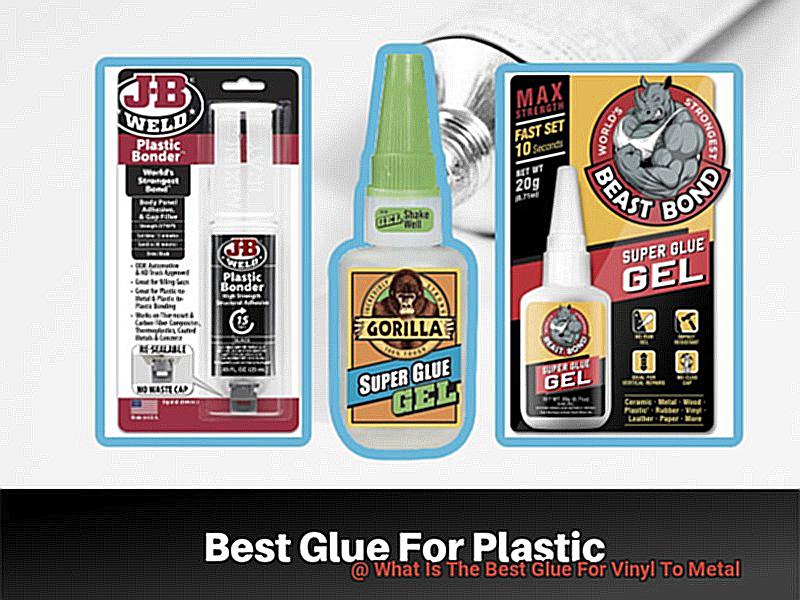
Different glues have varying curing times, ranging from minutes to hours or even days. To ensure success, it’s essential to follow the manufacturer’s instructions regarding the recommended curing time for the specific glue you’re using. They know what they’re talking about.

Now, let’s dive into how environmental conditions can affect curing time. Temperature and humidity play significant roles in the glue’s ability to set. Higher temperatures speed up the process, while lower temperatures slow it down. It’s like a race against time with Mother Nature as the referee. High humidity levels can prolong curing time, while low humidity levels can expedite it. It’s like she has a say in our bonding adventures. So, be mindful of your surroundings and adjust accordingly.
In addition to curing time, there are additional precautions you should take to ensure a strong and durable bond. During the curing period, handle the bonded materials with care. Avoid applying excessive force or stress that could compromise the bond. Let it rest and gain strength.
Creating a stable environment for your bond is also vital. Extreme temperatures or rapid changes can affect its integrity, so keep things steady. Protect the bonded area from moisture or water exposure during curing. We don’t want anything interfering with the adhesive’s ability to work its magic.
Enhancing the Performance with a Primer or Bonding Agent
Look no further. In this article, we will explore the remarkable world of primers and bonding agents and how they can revolutionize the performance of your adhesive bonds between vinyl and metal. Whether you are a DIY enthusiast or a seasoned professional, harnessing the power of these products will elevate your bonding game to new heights.
Primers – Laying the Foundation for Unbreakable Bonds:
- Understanding the role and significance of primers.
- Selecting the perfect primer for vinyl-to-metal bonding.
- Achieving optimal adhesion through proper surface preparation.
- A step-by-step application process to ensure success.
- Decoding the science behind bonding agents.
- Compatibility considerations for vinyl and metal.
- Elevating adhesion with specialized bonding agents.
- Choosing the ideal bonding agent for your adhesive.
- Fortifying porous surfaces against moisture intrusion.
- Shielding against corrosion and chemical exposure.
- Prolonging durability and longevity of adhesive bonds.
Bonding Agents – Unlocking the Secrets to Superior Bonds:
Bonus Benefits: Beyond Adhesion:
In conclusion, primers and bonding agents are formidable tools that significantly enhance the performance of adhesive bonds between vinyl and metal surfaces. By utilizing a primer, you establish an optimal surface for adhesive bonding, ensuring maximum strength in adhesion. Conversely, bonding agents work to enhance material compatibility and form additional chemical bonds, resulting in robust connections.
These products not only bolster adhesion but also offer supplementary advantages such as sealing porous surfaces, safeguarding against corrosion, and heightening resistance to moisture and chemicals. It is crucial to select a primer or bonding agent that is compatible with both vinyl and metal, while also meticulously cleaning and preparing the surfaces before application.
Also Read: How to Glue Vinyl to Metal?
Conclusion
In conclusion, when it comes to bonding vinyl to metal, the best glue option is a cyanoacrylate adhesive. This powerful adhesive forms an incredibly strong bond that can withstand the stress and strain of everyday use. It dries quickly and creates a durable connection between vinyl and metal surfaces.
Another excellent choice is an epoxy adhesive. This versatile glue offers exceptional strength and flexibility, making it perfect for joining vinyl and metal together. It provides a long-lasting bond that can endure temperature changes and exposure to moisture.
For smaller projects or temporary fixes, a super glue or instant adhesive can be effective. These adhesives bond quickly and securely, providing a temporary solution until a more permanent fix can be made.
It’s important to note that before applying any adhesive, proper surface preparation is crucial. Make sure both the vinyl and metal surfaces are clean, dry, and free from any contaminants or debris. This will ensure maximum adhesion and longevity of the bond.
In summary, choosing the best glue for vinyl to metal depends on the specific project requirements. Whether it’s cyanoacrylate adhesive for its strength, epoxy adhesive for its versatility, or super glue for quick fixes, there are options available to suit different needs.

